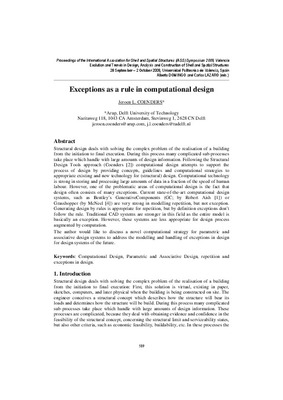JavaScript is disabled for your browser. Some features of this site may not work without it.
Buscar en RiuNet
Listar
Mi cuenta
Estadísticas
Ayuda RiuNet
Admin. UPV
Exception as a rule in computational design
Mostrar el registro sencillo del ítem
Ficheros en el ítem
| dc.contributor.author | COENDERS, Jeroen L
|
|
| dc.contributor.editor | Domingo Cabo, Alberto
|
es_ES |
| dc.contributor.editor | Lázaro Fernández, Carlos Manuel
|
es_ES |
| dc.date.accessioned | 2010-01-14T11:38:09Z | |
| dc.date.available | 2010-01-14T11:38:09Z | |
| dc.date.issued | 2010-01-14T11:38:09Z | |
| dc.identifier.isbn | 978-84-8363-461-5 | |
| dc.identifier.uri | http://hdl.handle.net/10251/6868 | |
| dc.description | p. 589-597 | en_EN |
| dc.description.abstract | Structural design deals with solving the complex problem of the realisation of a building from the initiation to final execution. During this process many complicated sub-processes take place which handle with large amounts of design information. Following the Structural Design Tools approach (Coenders [2]) computational design attempts to support the process of design by providing concepts, guidelines and computational strategies to appropriate existing and new technology for (structural) design. Computational technology is strong in storing and processing large amounts of data in a fraction of the speed of human labour. However, one of the problematic areas of computational design is the fact that design often consists of many exceptions. Current state-of-the-art computational design systems, such as Bentley's GenerativeComponents (GC; by Robert Aish [1]) or Grasshopper (by McNeel [4]) are very strong in modelling repetition, but not exception. Generating design by rules is appropriate for repetition, but by definition exceptions don't follow the rule. Traditional CAD systems are stronger in this field as the entire model is basically an exception. However, these systems are less appropriate for design process augmented by computation. The author would like to discuss a novel computational strategy for parametric and associative design systems to address the modelling and handling of exceptions in design for design systems of the future. | en_EN |
| dc.language | Inglés | en_EN |
| dc.publisher | Editorial Universitat Politècnica de València | es_ES |
| dc.relation.ispartof | Symposium of the International Association for Shell and Spatial Structures (50th. 2009. Valencia). Evolution and Trends in Design, Analysis and Construction of Shell and Spatial Structures : Proceedings | en_EN |
| dc.rights | Reserva de todos los derechos | en_EN |
| dc.subject | Computational design | en_EN |
| dc.subject | Parametric and associative design | en_EN |
| dc.subject | Repetition and exceptions in design | en_EN |
| dc.title | Exception as a rule in computational design | en_EN |
| dc.type | Comunicación en congreso | en_EN |
| dc.rights.accessRights | Abierto | es_ES |
| dc.description.bibliographicCitation | Coenders, JL. (2010). Exception as a rule in computational design. Editorial Universitat Politècnica de València. http://hdl.handle.net/10251/6868 | es_ES |
| dc.relation.conferencename | Symposium of the International Association for Shell and Spatial Structures | es_ES |
| dc.relation.conferencedate | 2009 | es_ES |
| dc.relation.conferenceplace | Valencia | es_ES |






